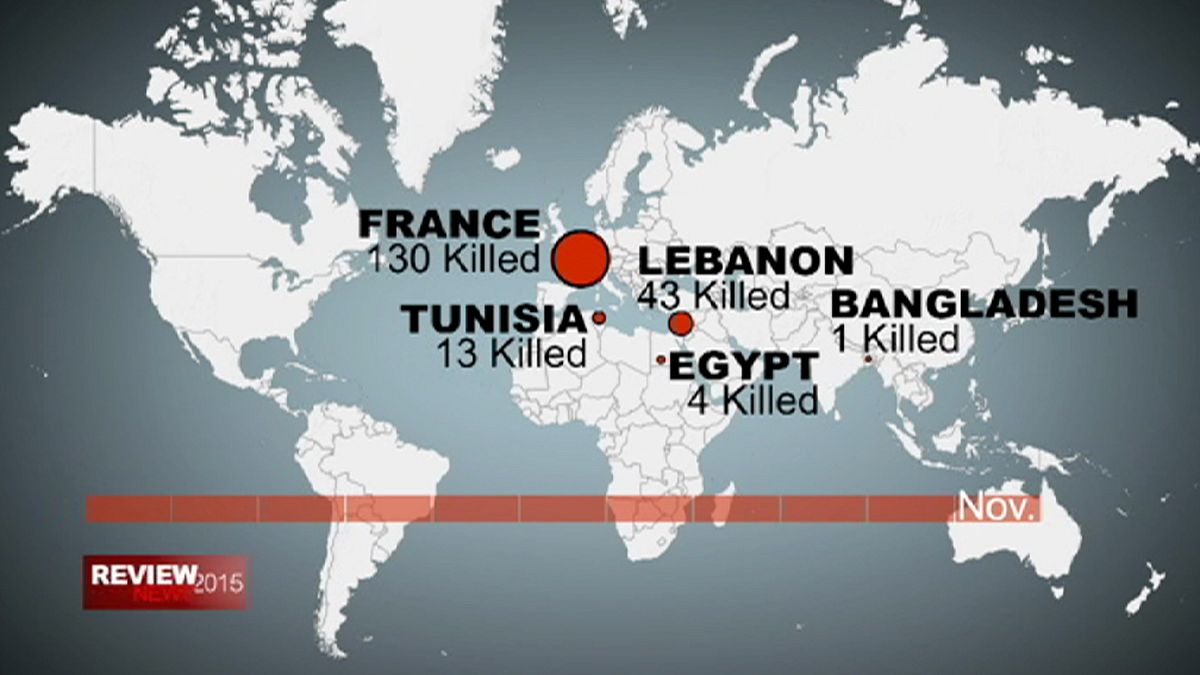The radical Islamic State movement (ISIL) pushed on with its offensive throughout the year. In Iraq and Syria, the jihadists took more territory
The radical Islamic State movement (ISIL) pushed on with its offensive throughout the year. In Iraq and Syria, the jihadists took more territory, pushing thousands into exile, spreading chaos far beyond the borders. Fighters came and went between Europe and the theatre of war, many also drawn from North Africa’s Arab Spring countries.
Attacks in January shocked the world. But more would just keep coming.
Shortly before noon on January 7th in Paris, two gunmen attacked the offices of the satirical newspaper Charlie Hebdo, killing 12 people. In the following days, a third associate linked to ISIL murdered a policewoman and attacked a Jewish supermarket in the French capital, killing four hostages. On January 11th, the French in their hundreds of thousands rallied for unity, joined by world leaders, honouring the victims. The slogan “I am Charlie” circled the world.
The cartoonist known as Luz, who had escaped the massacre, described the irony in the first post-killing Charlie Hebdo issue, whose front page showed the prophet Mohammed with the slogan under the headline “All is forgiven”.
In Kobani, northern Syria, , near the Turkish border, the only force significantly resisting ISIL for months were the Kurdish Peshmerga. With Western-led air support and allied armed groups, later in January the Kurds retook Kobani, pursuing ISIL, also known as Daesh, into the surrounding area.
Daesh stepped up its media campaign. It focused its fear propaganda on executing prisoners. The first American had been killed in 2014—a journalist. Then a Jordanian fighter pilot was captured and murdered, videoed as he burned. This recording was released on February 3rd.
Libya, Denmark and Yemen were targeted that month and the next.
Then it was Tunisia’s turn. On 18th March, three gunmen killed 24 tourists, mostly Europeans, at the National Bardo Museum in the capital Tunis, wounding dozens more—the deadliest terrorist attack in Tunisian history, with ISIL behind it.
In Syria, the archaeologically rich city of Palmyra fell to the jihadists. They stage-managed a mass execution of prisoners within the UNESCO heritage setting, then went about destroying it, piece by piece.
More blood was shed in the spring, in Libya, Yemen, Saudi Arabia, Turkey, Afghanistan. The main targets were foreigners.
At the end of June, on the 26th, in the resort of Port El Kantaoui, near Sousse in Tunisia, a gunman killed 38, mostly British tourists—even more deaths than at the Bardo Museum, this time on the beach.
ISIL had set off three car bombs in Kobani a day earlier, as the group renewed its attack with rockets and snipers. As many as 250 civilian deaths were reported, mostly Kurdish civilians, including women and children in houses and in the streets, also in outlying villages.
The outward flow of refugees increased, notably across Turkey, people struggling to reach Europe. They arrived on the shores of Greece—the islands—and walked across the Balkan countries. The land of humanist values was put to the test. Would Europe offer asylum or turn itself into a fortress? Rolls of razor wire and fences went up.
A three-year-old drowned and washed up on Bodrum beach in Turkey on September 2nd, Aylan Kurdi, from Syria, with his family trying to reach Greece, on a third attempt. The photos outraged public opinion and pricked political consciences, and stirred debate as far as Canada, which Aylan’s parents had tried to reach. Donations to charities rose. Europe reconsidered quotas for accepting asylum-seekers.
NGOs urged the international community to share the responsibility for taking in refugees. Hungary was the most vocal in rejecting such calls. It closed its border with Serbia. The refugees did not retreat.
Summer and autumn brought more off-battle-field attacks, in Egypt, Turkey, Saudi Arabia, Libya, Yemen and Bangladesh.
Ankara was hit on October 10th, outside its main train station, peaceful protesters against renewed hostilities between the Turkish government and Kurdish rebels. Two bombs claimed 102 lives, wounding 500. This was Turkey’s worst terrorist murder.
On October 31st, 224 people were killed when a Russian airliner crashed in the Egyptian Sinai. The mostly Russian vacationers had been returning to Saint Petersburg from Sharm el-Sheikh. ISIL claimed responsibility.
Had Moscow’s role in Syria made its civilians a target? In early October, at the official request of President Assad in Damascus, President Putin had launched air strikes against the regime’s opponents. Coordination with the US-led military intervention coalition was slow to evolve, and Washington disputed whether Putin’s strikes were strictly against ISIL, but it was now an increasingly common enemy.
Civilians seeking to flee were caught between more and more participants in the conflict. The flow desperate to enter Europe accelerated. German’s Chancellor Merkel continued to defend her open-arms policy begun in September, despite criticism at home and with EU partners. Borders tightened everywhere, humanitarian capacities strained—from Macedonia even to Sweden.
Now Lebanon was struck, and then France—again.
On 12th November, two suicide bombers in Beirut killed 43 people in a busy shopping area as evening was approaching, wounding more than 200. More victims of Daesh. The Lebanese Hezbollah supports the Syrian Army against ISIL.
Even worse befell Paris the next day, the 13th. On Friday evening, just after nine, the bars, terraces and concert halls had started to fill, when 130 were killed, in drive-by shootings and then point blank range executions; 350 were wounded. French spirit itself was attacked.
The country reeled from the shock once more. But while France mourned, the refugees continued to appeal for help as the year drew to a close.
They are still fleeing war; ISIL is still waging it; 2015 brought no relief.
